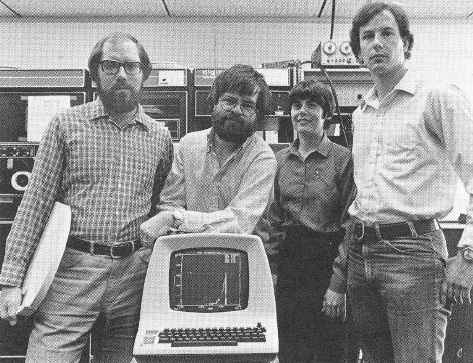MULTI/DA Gains Wide Use

(L-R) Joe Biel, Dave Ritchie, Liz Quigg and Bob Dosen show a typical physics display generated by their MULTI/DA software.
One of the most important but least visible parts of the high energy physics experiments at the Laboratory is the computer program (called software) which allows the experimenter to record data for later analysis. The purpose of this program is to give the experimenter access to the data and to manage the flow of data from the detectors through the minicomputer onto the magnetic tape for later analysis.
In the early days of the Laboratory, Al Brenner, head of the Computing Department, mandated a basic on-line computer hardware package. As a result, there are a large number of experiments using the same type of computer equipment. This approach was pioneered here at Fennilab and has allowed the development of a universal on-line software package for Fermilab experiments.
At the beginning, every experiment had its own specific data acquisition and analysis minicomputer software. One of these, developed by Fritz Bartlett (then at Caltech) and called MULTI, gained popularity, and was adopted by the Computer Department as a standard system. Principally, a data analysis and experimental control system, MULTI, has been expanded, documented and packaged for distribution by the Computing Department.
In addition, a standardized data acquisition package also has been developed, thereby creating the current total MULTI/DA software. These efforts were spearheaded in the Computing Department by Joe Biel, Dan Curtis, Bob Dosen, Terry Lagerlund, Liz Quigg, Dave Ritchie and Lou Taff. With this package, it is now possible to start up an experiment's on-line computer system in a matter of hours--even for a group who has no previous experience with this software or the Fennilab-supplied hardware.
As new software within the framework is developed by the Computing Department or by university user groups, it can be incorporated in the package and distributed for more general use. In addition, when new hardware which improves experimental capabilities becomes available, it can also be adopted in a most straightforward manner.
The success of this approach to data acquisition and analysis software is witnessed by its adoption by more than two-thirds of the experiments now running at Fermilab. This is the result of the ability of each experiment to quickly tailor the software to its own needs and to the ease with which the experimenter can learn how to use the system.


